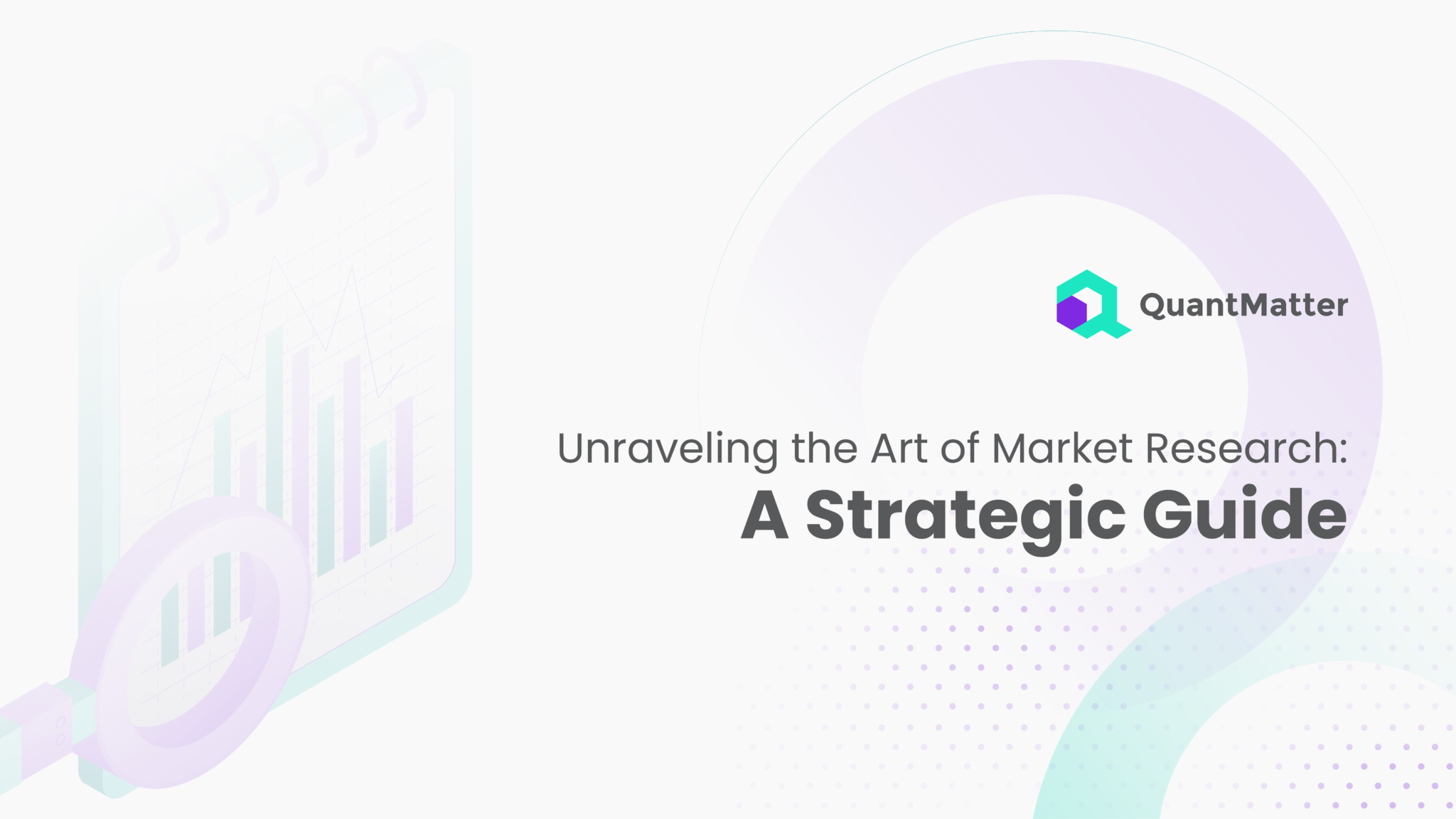
Market research serves as a foundation that underpins all informed decisions. It serves as a map to guide them in dynamic markets dictated by consumer interest rates, industry benchmarks and the competitive marketplace. The evolution of market research is a multidimensional and substantive process that does not bend to the restrictions of an ‘all-to-one’ solution. It is a process of adaptive, ongoing dynamics replicating the ever changing nature of the market, which it tries to understand.
Companies that make a commitment to in-depth and long term market research show advanced thinking, realizing that it takes not only an understanding of current market dynamics today when they do business but also that it has become necessary nowadays to take into consideration how it will progress in the future. In this paper, we are going to discuss market research as a key aspect of understanding the importance of understanding the various aspects that revolve around market research, the varieties associated with it, and how it enables businesses to make informed decisions.
Significance of Market Research

The term market research is not mere hype for the business community; it acts as an embodiment of one pillar that is responsible for determining the success or failure of enterprises across various industries. Analysing the market at a deeper level lead to discovering some insights that help organizations identify big opportunities, figure out possible risks, and modify products or services offered to customers. This becomes a pre-emptive approach based on market understanding that will help in developing sturdy marketing strategies that essentially allow us to preserve our competitive advantage amidst a dynamically changing business world.
Market research is a broad term that encompasses an array of activities that may entail anything from studying the behavioural dynamics and preferences of consumers to analysing competitor moves and industry trends. The analysis of this multitude of information provides businesses with a holistic perspective on the playing field so that better decisions are shaped in pursuit of what customers want most. Such insight-guided decision-making processes not only reduce the element of unpredictability but also help organizations in strategic planning to be adaptable to changing market trends.
In addition, market research is a continuous process whereby an individual or organization is alert to changes in consumer moods, emerging technologies and economic situations. The regular updates allow the businesses to be flexible as well as evolve, hence maintaining their hold on reacting quickly to changes in trends or strategies. Such continuous measurement of progress is like a guide for firms, making any errors in the previous directions and steering them towards untreaded paths.
Essentially, market research is the navigation compass of a business journey through the frightening maze of the marketplace. The device is more than a mere means of comprehending the current situation, as it serves as a forward-looking instrument that projects developments and lays the foundations for future undertakings. There is a need for market research to be incorporated into the core operations mandates and not viewed as just another strategic option by business organizations that are jostling for continued relevance.
Key Components of Market Research

Market research can be described as a holistic process with several segments that are important in collecting, analyzing and determining the types of information that inform decisions about business strategy.
1. Market Segmentation
Segmentation means cutting out the target market into homogenous sub-markets distinct in terms of segmentation variables. This enables businesses to segment their market through efficient methods and offerings that meet the unique needs and preferences of all target segments.
For example, demographic segmentation takes note of variables such as race, gender and income, whereas psychographic markers look into lifestyle brands, beliefs and attitudes. An effective targeting strategy makes sure of the optimal use of resources and thus helps to ensure that a truly appropriate marketing message is communicated to the targeted audience. Being a dynamic process, it quickly responds to changing consumption patterns that necessarily must keep businesses relevant in today’s structurally diverse and transient market.
2. Data Collection Methods
The mode of data collection is a key factor in getting relevant and true information. The quantitative approach uses surveys, questionnaires, and even analytics tools that help extract numerical data. In contrast, qualitative approaches make use of focus groups, interviews, and observational studies to offer in-depth information with regards to consumers’ attitudes and perceptions.
The approaches used consensual synergy, which contributes to the establishment of a holistic comprehension of the market. Moreover, new data collection methods have emerged alongside technological improvements, with the most recent being social media analytics and web scraping, which contribute significant other dimensions to the research procedure.
3. Competitor Analysis
Competitor analysis is a continuous strategy based on conducting meaningful research to figure out who its direct and indirect competitors are. It entails a critical analysis of their strategies, strengths, weaknesses, and the market position in which they are involved. This analysis enables businesses to identify gaps in the market, possible mergers or acquisitions that companies can bank on, as well as areas where they may create a competitive advantage through building distinctive capabilities.
Also Read: Market Maker Options: Definition and How They Make Money
The competitor website audit allows business people to make an informed analysis of competitors’ moves, see trends in their movement direction, and prepare their own strategy based on this understanding. At the same time, it is all about others mimicking best practices strategy: developing innovations and unique selling points that distinguish a business from its competitors.
4. SWOT Analysis
SWOT analysis is an application for the process where an organization formally uses its internal strengths and weaknesses to consider external opportunities and threats. Businesses are able to thus pinpoint those fundamental internal factors that make them unique, as well as areas for improvement and development.
The environmental level consists of market trends, economic circumstances and regulatory regimes, among others. This integrated analysis enables an informed strategic position as it pinpoints strengths to build on and interventions necessary at the same time. SWOT analysis is not, and cannot be, a one off event; it must be dynamic and always adapt to changes in the business environment.
Market Research Methodologies

The market research methods vary widely and involve a broad spectrum of processes and tools that are utilized to gather, review, and interpret data about the market, its consumers, as well as competitors. The above methodologies are paramount for businesses because their main goal is to make informed decisions, spot opportunities and remain competitive.
– Surveys and Questionnaires
The most common quantitative methods of research include surveys and questionnaires, which use a specific sample of people to collect and organize structured data. This type of investigation is specifically designed by businesses to make sure that they collect information on consumer preferences, attitudes and behaviors.
In addition, these tools are flexible as they enable large-scale aggregation of data from several aspects using online platforms such as phone interviews and even questionnaires sent through the mail service. However, despite the resounding efficacy of numerical information surfaced by surveys, careful design and analysis are needed to ensure that the results are also valid. Since there are plenty of questions that businesses can come up with in accordance with the targeted objectives of their own research surveys, these could be pretty versatile tools for understanding general market trends and attitudes among consumers.
– Focus Groups
Instinct groups are a qualitative research approach that consists of recruiting diverse participants to discuss particular topics using moderators. This type of methodology makes it possible for businesses to delve further into the minds of consumers, enabling a deeper understanding of consumer perceptions, attitudes and motivations.
By engaging in non-directed discussions, focus groups bring out hidden opinions and help develop an innovative idea to work on product development or end involve marketing. But on the other hand, qualitative data can be moderated only by a professional facilitator due to its subjective nature, and strict research will have to determine whether skillful art or science has been used in order to facilitate proper mediation between researchers and smooth communication. The limitations of using focus groups, such as group dynamics affecting the responses, and others, apart from those discussed by McGraw (2014), include emotions, motivations or other issues that have to also be identified with biometric solutions through eye tracking.
– In-Depth Interviews
Focus group interviews take place in groups instead of individual ones and are conducted among several participants simultaneously, creating a conducive setting that enables the exploration of complicated issues. Qualitative analyses permit detailed investigation into personal points of view, experiences and decision-making procedures.
Also Read: Market Making: Strategies and Techniques
Businesses often use in-depth interviews as a means to collect deep and specific details within a particular context that could have gone unnoticed in overall or wide scale surveys. One of the most typical types of interviews conducted in consumer research is one that leads to discovering some unconscious factors affecting consumer behavior. Though expensive and time-consuming, the richness of information derived from an in-depth interview makes it a technology that can be used by businesses to understand the needs of segments, particularly if they are untapped markets.
– Observational Research
The observer method, or observational research, involves direct observation and documentation of consumer behavior in their natural environments through means that do not affect the subject’s actions. This approach has been considered one of the most effective ways to realize individuals’ behavior towards products, services, or environments in actual environments.
Businesses can get hands on information that can reveal certain patterns, preferences and possible pain points that might not be noticeable with data obtained through self-report. This is further enhanced by ethnographic research, which is a type of observational research that will observe how consumers are living within their culture in order to establish cultural differences and influences from the environment. However, observational research provides an insider’s point of view, but it demands foresight into minimizing bias and adhering to moral principles.
5 Ways to Navigate Challenges in Market Research
A great deal of the process is about being challenged as part of making sure that market research provides valid and viable results. Market research is a valuable means of collecting information, but some major hurdles may affect each step of the process’s accuracy and efficiency.
1. Sampling Bias
If sampling bias starts to additionally distort the results of the market research, it can significantly decrease their accuracy since some factors may not correspond with those that largely characterize a broader population. However, the issue of lack of practical randomness is especially pronounced when researchers struggle with the actuality of obtaining a truly random and diverse sample from which to extend their results.
The consequences of sampling bias can sometimes be huge, limiting the external validity of the study’s results To tackle the challenge, designers need a well-designed sampling strategy; all determinants of sampling must be made perfect. For instance, techniques involving random sampling, stratified sampling of the participant space, or oversampling underrepresented groups could help to ensure that any insights gathered are reflective of the real diversity existing within the target population. Sampling bias refers to the fact that samples might not be representative of the population under study, and if taken care of, this can improve reliability and validity during research, helping businesses make decisions.
2. Data Quality and Integrity
The primary thing that should be noted in the context of market research is the importance of data quality and integrity, which serve to preserve its reliability. Wrong or almost accurate data can completely mislead the entire process of the analysis, and unfortunate decisions in business most end up making.
In spite of the existence of credible research, reliable data collection methods must be used to ensure that information in this regard is correct and comprehensive. This involves using trustworthy tools, verifying the data sources, and performing quality control checks during the research. The validity of the data is essential, as it influences not only the credibility of this study but generally how future analyses or strategic decisions using that same data may be perceived by other individuals. This is rather helpful, as the rigorous data quality allows us to justify the results, and a lot of companies tend to make good decisions based on information.
3. Respondent Bias
One more reason for the issue is respondent bias; participants might give wrong or socially desired answers and thus change the true performance of the researched dataset. Social desirability, respondent fatigue and the desire to figure out what the researcher wants could lead to this bias. One of the ways to overcome this challenge is by meticulously devising surveys and questionnaires with specific attention to language that mirrors the target audience’s understanding.
The use of objective wording, the lack of leading questions, and the assurance that respondent anonymity protect participants from stereotypical moral norms or anything specific to their way of life. Alternatively, it is possible to implement the combination of both quantitative and qualitative methodologies as a sort of mutual cross verification strategy that can reduce the influence of respondents’ bias on overall research outcomes. By addressing this particular difficulty, organizations can improve the integrity of their insights and develop a better understanding of the considerations used by consumers.
4. Privacy considerations
As well as ethics, these are among the things that impact market researchers and will continue to play a role in an era where technology continues to advance. Thus, mishandling of personal information results in breaches of trust, and the validity of research is compromised. The researchers must maintain vigilance as regards the regulations put in place to protect the data and support strong security measures before handling and transparency in practice about proper communication practices regarding the handling of data between researcher participants.
The method of tackling and managing data through the use of technology should be guided by ethical concerns, letting a researcher try their best as much as possible to maintain privacy and later continue with other aspects. The way businesses manage the intricacy of balancing between both technological progress and privacy issues is, hence, enabled by their enjoyment while observing how results assure trust.
5. Dynamic Market Conditions
Massive change in markets becomes a major issue for contemporary studies that use traditional research methods, as the insights gathered via this approach can never be immediate. This issue can be tackled not only in traditional ways but also through dynamic approaches such as real-time data analytics, social media listening and trend analysis.
Such methodologies deliver more relevant data, enabling firms to implement effective change plans that respond timely to changing customers’ behavior, trends in their markets, and so forth. The fact that businesses embrace the fluid nature of markets implies that the research initiatives intended to drive decision making processes remain effective and productive; hence, institutions are able to make appropriate, timely strategic decisions.
Conclusion
Just like the compass used in an unpredictable land, market research helps to explore any ground. Organizations using this strategic instrument secure competitive advantages due to their managed ability to risk-taking with informed or guided choices. The concepts that are extracted from a disciplined approach to investigation turn into the compass needle, which points out opportunities that would have remained embedded in their shadows otherwise. By adopting this preventive strategy, businesses not only survive threats but also anticipate and exploit emerging issues, creating a pauldron market that supports their dynamic configurations.
In addition, market research stands as a hinge for all companies that strive to survive ahead of competitors. With the constant fluctuations in consumer preferences, new technologies, and large-scale shifts in the global economy, people must periodically check what is going on with the market. Market research becomes a strategic substructure for organizations, thus aiding in the development of flexibility and responsiveness. Awareness of characteristics in consumer behavior and changes in market conditions helps them develop offerings, improve ideas on offerings, and outsmart competitors.
Disclaimer: The information provided by Quant Matter in this article is intended for general informational purposes and does not reflect the company’s opinion. It is not intended as investment advice or a recommendation. Readers are strongly advised to conduct their own thorough research and consult with a qualified financial advisor before making any financial decisions.
I craft stories that make complex ideas clear. I simplify the blend of data science, machine learning, and crypto trading, showcasing how advanced tech and quantitative models analyze data for informed trading choices. Join me in exploring the realm of quantitative trading, where my narratives make intricate concepts easy to grasp.
-
Alifia Berizkyhttps://quantmatter.com/author/alifia-berizky/
-
Alifia Berizkyhttps://quantmatter.com/author/alifia-berizky/
-
Alifia Berizkyhttps://quantmatter.com/author/alifia-berizky/
-
Alifia Berizkyhttps://quantmatter.com/author/alifia-berizky/

